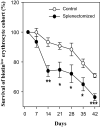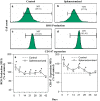Splenectomy Modulates the Erythrocyte Turnover and Basigin (CD147) Expression in Mice
- PMID: 33100715
- PMCID: PMC7573055
- DOI: 10.1007/s12288-020-01272-1
Splenectomy Modulates the Erythrocyte Turnover and Basigin (CD147) Expression in Mice
Abstract
The present study was designed to study the splenectomy induced modulation of erythrocyte turnover in mice. We have also studied the modulation of reactive oxygen species (ROS) and basigin (CD147) expression level on erythrocytes in splenectomized condition. The erythrocyte turnover was studied by a newly developed double in vivo biotinylation (DIB) technique. This technique enables to discriminate three different age (young, intermediate and old) groups of erythrocytes. The expression level of ROS and CD147 was studied by staining with CM-H2DCFDA stain and anti-mouse CD147 monocloclonal antibody followed by flow cytometry. We observed that intermediate and old age groups of erythrocytes were randomly eliminated in splenectomized condition. A marked surge in the blood reticulocyte count was observed in splenectomized mice. Splenectomy induced the level of ROS and CD147 expression on erythrocytes. The expression level of ROS was induced up to 35 days, but it reversed to basal level by 42 days indicating the emergence of refractoriness to splenectomy. The CD147 expression was significantly higher on day 7, 21 and 28 but it also normalizes on later time points. We conclude that erythrocyte turnover is significantly modulated in splenectomized mice. The enhanced level of ROS and CD147 expression may be a possible cause to increase erythrocyte removal in splenectomized mice.
Keywords: Basigin; Double in vivo biotinylation; Erythrocyte; Flow cytometry; Reactive oxygen species; Splenectomy.
© Indian Society of Hematology and Blood Transfusion 2020.
Conflict of interest statement
Conflict of interestThe authors declare no conflict of interest.
Figures




Similar articles
-
A Double in vivo Biotinylation Technique for Objective Assessment of Aging and Clearance of Mouse Erythrocytes in Blood Circulation.Transfus Med Hemother. 2012 Oct;39(5):335-41. doi: 10.1159/000342524. Epub 2012 Sep 6. Transfus Med Hemother. 2012. PMID: 23801925 Free PMC article.
-
Selective elimination of younger erythrocytes in blood circulation and associated molecular changes in benzo (a) pyrene induced mouse model of lung cancer.Toxicol Res (Camb). 2023 Dec 5;13(1):tfad115. doi: 10.1093/toxres/tfad115. eCollection 2024 Feb. Toxicol Res (Camb). 2023. PMID: 38178996 Free PMC article.
-
Assessment of survival of aging erythrocyte in circulation and attendant changes in size and CD147 expression by a novel two step biotinylation method.Exp Gerontol. 2006 Sep;41(9):855-61. doi: 10.1016/j.exger.2006.06.045. Epub 2006 Aug 4. Exp Gerontol. 2006. PMID: 16889925
-
Basigin: a multifunctional membrane protein with an emerging role in infections by malaria parasites.Expert Opin Ther Targets. 2012 Oct;16(10):999-1011. doi: 10.1517/14728222.2012.711818. Epub 2012 Aug 11. Expert Opin Ther Targets. 2012. PMID: 22880881 Review.
-
Role of CD147 (EMMPRIN/Basigin) in Tissue Remodeling.Anat Rec (Hoboken). 2020 Jun;303(6):1584-1589. doi: 10.1002/ar.24089. Epub 2019 Mar 15. Anat Rec (Hoboken). 2020. PMID: 30768865 Review.
Cited by
-
Benzo (A) pyrene exposure alters alveolar epithelial and macrophage cells diversity and induces antioxidant responses in lungs.Toxicol Rep. 2024 Oct 18;13:101777. doi: 10.1016/j.toxrep.2024.101777. eCollection 2024 Dec. Toxicol Rep. 2024. PMID: 39506978 Free PMC article.
-
Hemolytic anemia in COVID-19.Ann Hematol. 2022 Sep;101(9):1887-1895. doi: 10.1007/s00277-022-04907-7. Epub 2022 Jul 8. Ann Hematol. 2022. PMID: 35802164 Free PMC article. Review.
-
P. falciparum Invasion and Erythrocyte Aging.Cells. 2024 Feb 12;13(4):334. doi: 10.3390/cells13040334. Cells. 2024. PMID: 38391947 Free PMC article. Review.
References
LinkOut - more resources
Full Text Sources
